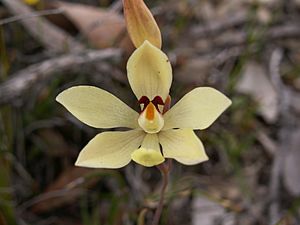Rabbit-eared sun orchid facts for kids
Quick facts for kids Rabbit-eared sun orchid |
|
|---|---|
 |
|
| Thelymitra antennifera in the Stirling Range National Park. | |
| Scientific classification | |
| Genus: |
Thelymitra
|
| Species: |
antennifera
|
| Synonyms | |
|
Macdonaldia antennifera Lindl. |
|
The rabbit-eared sun orchid is a special type of orchid. It is also known as the lemon-scented sun orchid or vanilla orchid. Its scientific name is Thelymitra antennifera.
This beautiful flower grows naturally in parts of Australia. You can find it in Western Australia, South Australia, Victoria, and northern Tasmania.
What Does It Look Like?
The rabbit-eared sun orchid is a plant that grows from a tuber (a swollen underground stem, like a potato). It is a perennial herb, meaning it lives for more than two years. These orchids usually grow between 10 and 25 centimeters (about 4 to 10 inches) tall.
They have bright yellow flowers that bloom from July to October. Each flower is about 2 to 4 centimeters (about 1 to 1.5 inches) wide. They often smell like fresh lemons or sweet vanilla!
The plant has a single leaf that is round like a tube. It is about 5 to 12 centimeters long and very thin. The flowers grow on a thin, zig-zag shaped stem, which can sometimes look a bit pink.
Each flower has parts called sepals and petals. These are usually 12 to 20 millimeters long. The sepals often have a wide, reddish-brown stripe on the outside. The center part of the flower, called the column, has dark brown parts that look like little ears sticking up. This is why it's called the "rabbit-eared" orchid!
Where It Grows
This orchid is found in many areas of Western Australia, South Australia, and Victoria. In Tasmania, it is much rarer and is considered an endangered species. This means there are very few of them left in Tasmania, and they need protection.
The rabbit-eared sun orchid grows in many different places. It likes areas with shrubs, heathlands, and mallee (a type of Australian bushland). Sometimes, after a bushfire, these orchids grow in large groups and flower very well.
How It Gets Its Name
The rabbit-eared sun orchid was first described in 1840 by a scientist named John Lindley. He first called it Macdonaldia antennifera. Later, another English botanist, Joseph Dalton Hooker, gave it the name Thelymitra antennifera.
The name antennifera comes from a Latin word meaning "antenna-bearing." This refers to the ear-like parts on the flower's column, which look a bit like antennae.
Growing This Orchid
Like other Thelymitra species, the rabbit-eared sun orchid can be grown in pots. This can help protect the plant, especially in places where it is endangered.
See also
 In Spanish: Thelymitra antennifera para niños
In Spanish: Thelymitra antennifera para niños

